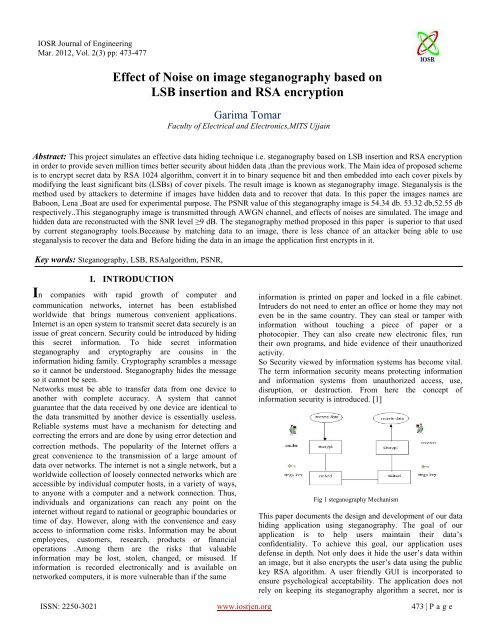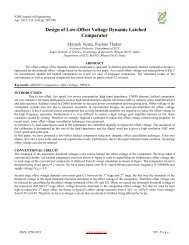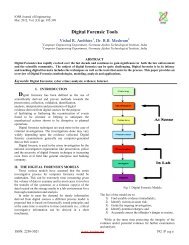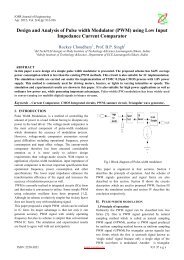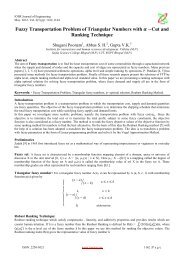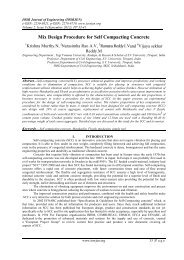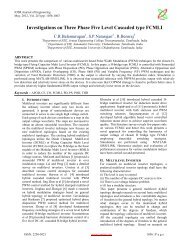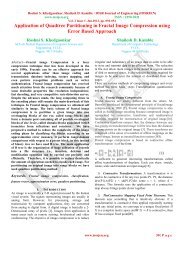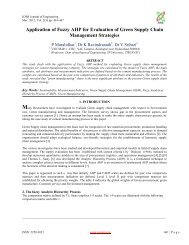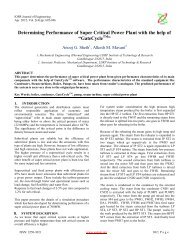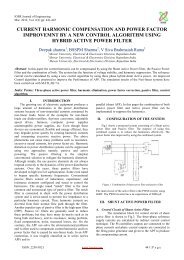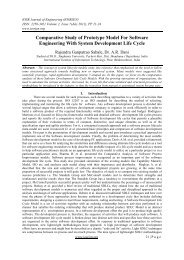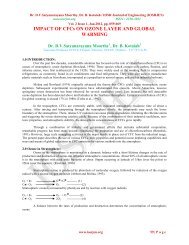Effect of Noise on image steganography based on LSB ... - IOSRJEN
Effect of Noise on image steganography based on LSB ... - IOSRJEN
Effect of Noise on image steganography based on LSB ... - IOSRJEN
Create successful ePaper yourself
Turn your PDF publications into a flip-book with our unique Google optimized e-Paper software.
IOSR Journal <str<strong>on</strong>g>of</str<strong>on</strong>g> Engineering<br />
Mar. 2012, Vol. 2(3) pp: 473-477<br />
<str<strong>on</strong>g>Effect</str<strong>on</strong>g> <str<strong>on</strong>g>of</str<strong>on</strong>g> <str<strong>on</strong>g>Noise</str<strong>on</strong>g> <strong>on</strong> <strong>image</strong> <strong>steganography</strong> <strong>based</strong> <strong>on</strong><br />
<strong>LSB</strong> inserti<strong>on</strong> and RSA encrypti<strong>on</strong><br />
Garima Tomar<br />
Faculty <str<strong>on</strong>g>of</str<strong>on</strong>g> Electrical and Electr<strong>on</strong>ics,MITS Ujjain<br />
Abstract: This project simulates an effective data hiding technique i.e. <strong>steganography</strong> <strong>based</strong> <strong>on</strong> <strong>LSB</strong> inserti<strong>on</strong> and RSA encrypti<strong>on</strong><br />
in order to provide seven milli<strong>on</strong> times better security about hidden data ,than the previous work. The Main idea <str<strong>on</strong>g>of</str<strong>on</strong>g> proposed scheme<br />
is to encrypt secret data by RSA 1024 algorithm, c<strong>on</strong>vert it in to binary sequence bit and then embedded into each cover pixels by<br />
modifying the least significant bits (<strong>LSB</strong>s) <str<strong>on</strong>g>of</str<strong>on</strong>g> cover pixels. The result <strong>image</strong> is known as <strong>steganography</strong> <strong>image</strong>. Steganalysis is the<br />
method used by attackers to determine if <strong>image</strong>s have hidden data and to recover that data. In this paper the <strong>image</strong>s names are<br />
Babo<strong>on</strong>, Lena ,Boat are used for experimental purpose. The PSNR value <str<strong>on</strong>g>of</str<strong>on</strong>g> this <strong>steganography</strong> <strong>image</strong> is 54.34 db. 53.32 db,52.55 db<br />
respectively..This <strong>steganography</strong> <strong>image</strong> is transmitted through AWGN channel, and effects <str<strong>on</strong>g>of</str<strong>on</strong>g> noises are simulated. The <strong>image</strong> and<br />
hidden data are rec<strong>on</strong>structed with the SNR level ≥9 dB. The <strong>steganography</strong> method proposed in this paper is superior to that used<br />
by current <strong>steganography</strong> tools.Beceause by matching data to an <strong>image</strong>, there is less chance <str<strong>on</strong>g>of</str<strong>on</strong>g> an attacker being able to use<br />
steganalysis to recover the data and Before hiding the data in an <strong>image</strong> the applicati<strong>on</strong> first encrypts in it.<br />
Key words: Steganography, <strong>LSB</strong>, RSAalgorithm, PSNR,<br />
I. INTRODUCTION<br />
In companies with rapid growth <str<strong>on</strong>g>of</str<strong>on</strong>g> computer and<br />
communicati<strong>on</strong> networks, internet has been established<br />
worldwide that brings numerous c<strong>on</strong>venient applicati<strong>on</strong>s.<br />
Internet is an open system to transmit secret data securely is an<br />
issue <str<strong>on</strong>g>of</str<strong>on</strong>g> great c<strong>on</strong>cern. Security could be introduced by hiding<br />
this secret informati<strong>on</strong>. To hide secret informati<strong>on</strong><br />
<strong>steganography</strong> and cryptography are cousins in the<br />
informati<strong>on</strong> hiding family. Cryptography scrambles a message<br />
so it cannot be understood. Steganography hides the message<br />
so it cannot be seen.<br />
Networks must be able to transfer data from <strong>on</strong>e device to<br />
another with complete accuracy. A system that cannot<br />
guarantee that the data received by <strong>on</strong>e device are identical to<br />
the data transmitted by another device is essentially useless.<br />
Reliable systems must have a mechanism for detecting and<br />
correcting the errors and are d<strong>on</strong>e by using error detecti<strong>on</strong> and<br />
correcti<strong>on</strong> methods. The popularity <str<strong>on</strong>g>of</str<strong>on</strong>g> the Internet <str<strong>on</strong>g>of</str<strong>on</strong>g>fers a<br />
great c<strong>on</strong>venience to the transmissi<strong>on</strong> <str<strong>on</strong>g>of</str<strong>on</strong>g> a large amount <str<strong>on</strong>g>of</str<strong>on</strong>g><br />
data over networks. The internet is not a single network, but a<br />
worldwide collecti<strong>on</strong> <str<strong>on</strong>g>of</str<strong>on</strong>g> loosely c<strong>on</strong>nected networks which are<br />
accessible by individual computer hosts, in a variety <str<strong>on</strong>g>of</str<strong>on</strong>g> ways,<br />
to any<strong>on</strong>e with a computer and a network c<strong>on</strong>necti<strong>on</strong>. Thus,<br />
individuals and organizati<strong>on</strong>s can reach any point <strong>on</strong> the<br />
internet without regard to nati<strong>on</strong>al or geographic boundaries or<br />
time <str<strong>on</strong>g>of</str<strong>on</strong>g> day. However, al<strong>on</strong>g with the c<strong>on</strong>venience and easy<br />
access to informati<strong>on</strong> come risks. Informati<strong>on</strong> may be about<br />
employees, customers, research, products or financial<br />
operati<strong>on</strong>s .Am<strong>on</strong>g them are the risks that valuable<br />
informati<strong>on</strong> may be lost, stolen, changed, or misused. If<br />
informati<strong>on</strong> is recorded electr<strong>on</strong>ically and is available <strong>on</strong><br />
networked computers, it is more vulnerable than if the same<br />
informati<strong>on</strong> is printed <strong>on</strong> paper and locked in a file cabinet.<br />
Intruders do not need to enter an <str<strong>on</strong>g>of</str<strong>on</strong>g>fice or home they may not<br />
even be in the same country. They can steal or tamper with<br />
informati<strong>on</strong> without touching a piece <str<strong>on</strong>g>of</str<strong>on</strong>g> paper or a<br />
photocopier. They can also create new electr<strong>on</strong>ic files, run<br />
their own programs, and hide evidence <str<strong>on</strong>g>of</str<strong>on</strong>g> their unauthorized<br />
activity.<br />
So Security viewed by informati<strong>on</strong> systems has become vital.<br />
The term informati<strong>on</strong> security means protecting informati<strong>on</strong><br />
and informati<strong>on</strong> systems from unauthorized access, use,<br />
disrupti<strong>on</strong>, or destructi<strong>on</strong>. From here the c<strong>on</strong>cept <str<strong>on</strong>g>of</str<strong>on</strong>g><br />
informati<strong>on</strong> security is introduced. [1]<br />
Fig 1 <strong>steganography</strong> Mechanism<br />
This paper documents the design and development <str<strong>on</strong>g>of</str<strong>on</strong>g> our data<br />
hiding applicati<strong>on</strong> using <strong>steganography</strong>. The goal <str<strong>on</strong>g>of</str<strong>on</strong>g> our<br />
applicati<strong>on</strong> is to help users maintain their data‟s<br />
c<strong>on</strong>fidentiality. To achieve this goal, our applicati<strong>on</strong> uses<br />
defense in depth. Not <strong>on</strong>ly does it hide the user‟s data within<br />
an <strong>image</strong>, but it also encrypts the user‟s data using the public<br />
key RSA algorithm. A user friendly GUI is incorporated to<br />
ensure psychological acceptability. The applicati<strong>on</strong> does not<br />
rely <strong>on</strong> keeping its <strong>steganography</strong> algorithm a secret, nor is<br />
ISSN: 2250-3021 www.iosrjen.org 473 | P a g e
IOSR Journal <str<strong>on</strong>g>of</str<strong>on</strong>g> Engineering<br />
Mar. 2012, Vol. 2(3) pp: 473-477<br />
RSA a secret algorithm; our applicati<strong>on</strong> follows the secure<br />
programming principle <str<strong>on</strong>g>of</str<strong>on</strong>g> open design. To combat<br />
steganalysis, our applicati<strong>on</strong> performs an analysis <strong>on</strong> the<br />
user‟s library <str<strong>on</strong>g>of</str<strong>on</strong>g> <strong>image</strong>s. This analysis allows users to hide<br />
their data in the <strong>image</strong> that is least likely to be vulnerable to<br />
steganalysis.In this paper also simulates the rec<strong>on</strong>structi<strong>on</strong><br />
performance <str<strong>on</strong>g>of</str<strong>on</strong>g> stego <strong>image</strong> at receiver when these <strong>image</strong>s are<br />
transmitted through AWGN channel.<br />
II. RELAT ED WORK<br />
There are many <strong>steganography</strong> tools which are capable <str<strong>on</strong>g>of</str<strong>on</strong>g><br />
hiding data within an <strong>image</strong>. These tools can be classified into<br />
five categories <strong>based</strong> <strong>on</strong> their algorithms: (1) spatial domain<br />
<strong>based</strong> tools; (2) transform domain <strong>based</strong> tools; (3) document<br />
<strong>based</strong> tools; (4) file structure <strong>based</strong> tools; and (5) other<br />
categories such as video compress encoding and spread<br />
spectrum technique <strong>based</strong> tools [2]. The spatial domain <strong>based</strong><br />
<strong>steganography</strong> tools use either the <strong>LSB</strong> or Bit Plane<br />
Complexity Segmentati<strong>on</strong> (BPCS) algorithm. The <strong>LSB</strong><br />
algorithm uses either a sequential or scattered embedding<br />
schemes for hiding the message bits in the <strong>image</strong>. In the<br />
sequential embedding scheme, the <strong>LSB</strong>s <str<strong>on</strong>g>of</str<strong>on</strong>g> the <strong>image</strong> are<br />
replaced by the message bit sequentially (i.e. <strong>on</strong>e by <strong>on</strong>e in<br />
order, as menti<strong>on</strong>ed in the introducti<strong>on</strong>). In the scattered<br />
embedding scheme, the message bits are randomly scattered<br />
throughout the whole <strong>image</strong> using a random sequence to<br />
c<strong>on</strong>trol the embedding sequence. Two basic types <str<strong>on</strong>g>of</str<strong>on</strong>g> <strong>LSB</strong><br />
modificati<strong>on</strong>s can be used for the embedding schemes<br />
described above. They are <strong>LSB</strong> replacement and <strong>LSB</strong><br />
matching. In <strong>LSB</strong> replacement, the <strong>LSB</strong> <str<strong>on</strong>g>of</str<strong>on</strong>g> the carrier is<br />
replaced by the message bit directly. On the other hand, in<br />
<strong>LSB</strong> matching if the <strong>LSB</strong> <str<strong>on</strong>g>of</str<strong>on</strong>g> the cover pixel is the same as the<br />
message bit, then it remains unchanged;<br />
Otherwise, it is randomly incremented or decremented by <strong>on</strong>e.<br />
This technique, however, requires both the sender and the<br />
receiver to have the same original <strong>image</strong>, which makes <strong>LSB</strong><br />
matching very inc<strong>on</strong>venient [2]. The current Steganography<br />
tools <strong>based</strong> <strong>on</strong> the <strong>LSB</strong> algorithms include S-Tools, Hide and<br />
Seek, Hide4PGP and Secure Engine Pr<str<strong>on</strong>g>of</str<strong>on</strong>g>essi<strong>on</strong>al. These tools<br />
support BMP, GIF, PNG <strong>image</strong>s and WAV audio files as the<br />
carriers [2]. Each <str<strong>on</strong>g>of</str<strong>on</strong>g> these tools has unique features. S-Tools<br />
reduce the number <str<strong>on</strong>g>of</str<strong>on</strong>g> colors in the <strong>image</strong> to <strong>on</strong>ly 32 colors.<br />
Hide and Seek makes all the palette entries divisible by four.<br />
In additi<strong>on</strong>, it forces the <strong>image</strong>s sizes to be 320x200, 320x400,<br />
320x480, 640x400 or 1024x768 pixels.Hide4PGP embeds the<br />
message in every <strong>LSB</strong> <str<strong>on</strong>g>of</str<strong>on</strong>g> an 8-bit BMP <strong>image</strong>s, and in every<br />
fourth <strong>LSB</strong> <str<strong>on</strong>g>of</str<strong>on</strong>g> a 24- bit BMP <strong>image</strong>. These applicati<strong>on</strong>s are<br />
flawed because they do not analyze the <strong>image</strong> file after it has<br />
been embedded with data to<br />
see how vulnerable it is to steganalysis. The transform domain<br />
<strong>based</strong> <strong>steganography</strong> tools embed the message in the transform<br />
coefficients <str<strong>on</strong>g>of</str<strong>on</strong>g> the <strong>image</strong>. The main transform domain<br />
algorithm is JSteg [2].These applicati<strong>on</strong>s can <strong>on</strong>ly work with<br />
JPGs because most other <strong>image</strong> formats do not perform<br />
transforms <strong>on</strong> their data. The document <strong>based</strong> <strong>steganography</strong><br />
tools embed the secret<br />
message in document files by adding tabs or spaces to .txt or<br />
.doc files [2]. These applicati<strong>on</strong>s are limited because they <strong>on</strong>ly<br />
work with document files. They also cannot hide much data<br />
because there are a very limited number <str<strong>on</strong>g>of</str<strong>on</strong>g> tabs or spaces they<br />
can reas<strong>on</strong>ably be added to a document. In additi<strong>on</strong>, they are<br />
vulnerable to steganalysis because it is easy for an attacker to<br />
notice a document file that has been embedded with additi<strong>on</strong>al<br />
tabs or spaces. The file structure <strong>based</strong> <strong>steganography</strong> tools<br />
embed the secret message in the redundant bits <str<strong>on</strong>g>of</str<strong>on</strong>g> a cover file<br />
such as the reserved bits in the file header or the marker<br />
segments in the file format [2]. These applicati<strong>on</strong>s cannot hide<br />
very large data files because there are a very limited number<br />
<str<strong>on</strong>g>of</str<strong>on</strong>g> header or marker segments available for embedding hidden<br />
data.<br />
There are also <strong>steganography</strong> tools <strong>based</strong> <strong>on</strong> video<br />
compressi<strong>on</strong> and spread spectrum techniques. The large size<br />
Of video files provides more usable space for hiding <str<strong>on</strong>g>of</str<strong>on</strong>g> the<br />
message. The spread spectrum technique spreads the energy <str<strong>on</strong>g>of</str<strong>on</strong>g><br />
embedded message to a wide frequency band, making the<br />
hidden message difficult to detect [2]. These <strong>steganography</strong><br />
tools are inc<strong>on</strong>venient because they require the users to send<br />
an entire video file every time they want to send hidden data.<br />
III LEAST SIGNIFICANT BIT INSERTION METHOD<br />
Least significant bit inserti<strong>on</strong> is a comm<strong>on</strong>, simple approach to<br />
embed informati<strong>on</strong> in a cover file [3]. Usually, three bits from<br />
each pixel can be stored to hide an <strong>image</strong> in the <strong>LSB</strong>s <str<strong>on</strong>g>of</str<strong>on</strong>g> each<br />
byte <str<strong>on</strong>g>of</str<strong>on</strong>g> a 24-bit <strong>image</strong>. The resulting stego-<strong>image</strong> will be<br />
displayed indistinguishable to the cover <strong>image</strong> in human visual<br />
system [4].<br />
Fig. 2: Least Significant Bit<br />
The last bit <str<strong>on</strong>g>of</str<strong>on</strong>g> the byte is selected as least significant bit in <strong>on</strong>e<br />
bit <strong>LSB</strong> as illustrated in Figure 2 because <str<strong>on</strong>g>of</str<strong>on</strong>g> the impact <str<strong>on</strong>g>of</str<strong>on</strong>g> the<br />
bit to the minimum degradati<strong>on</strong> <str<strong>on</strong>g>of</str<strong>on</strong>g> <strong>image</strong>s [5]. The last bit or<br />
also known as right-most bit is selected as least significant bit,<br />
due to the c<strong>on</strong>venti<strong>on</strong> in positi<strong>on</strong>al notati<strong>on</strong> <str<strong>on</strong>g>of</str<strong>on</strong>g> writing less<br />
significant digit further to the right [6]. In bit additi<strong>on</strong>, the<br />
least significant bit has the useful property <str<strong>on</strong>g>of</str<strong>on</strong>g> changing rapidly<br />
if the number changes slightly. For example, if 1 (binary<br />
00000001) is added to 3 (binary00000011), the result will be 4<br />
(binary 00000100) and three <str<strong>on</strong>g>of</str<strong>on</strong>g> the least significant bits will<br />
change (011 to 100).<br />
ISSN: 2250-3021 www.iosrjen.org 474 | P a g e
IOSR Journal <str<strong>on</strong>g>of</str<strong>on</strong>g> Engineering<br />
Mar. 2012, Vol. 2(3) pp: 473-477<br />
A simulati<strong>on</strong> results when secret data bits are hide in cover<br />
<strong>image</strong><br />
TABLE 3 SIMULATION RESULS WHEN SECRET<br />
DATA BITS ARE HIDE IN COVER IMAGE<br />
Name <str<strong>on</strong>g>of</str<strong>on</strong>g> Embedding PSNR in db<br />
the <strong>image</strong>s secret data<br />
capacity in bits<br />
Babo<strong>on</strong> 65536 54.34<br />
Fig. 3: Example <str<strong>on</strong>g>of</str<strong>on</strong>g> bit additi<strong>on</strong><br />
There are numbers <str<strong>on</strong>g>of</str<strong>on</strong>g> steganograpic tools which employ <strong>LSB</strong><br />
inserti<strong>on</strong> methods available <strong>on</strong> the web. For example, S-Tools<br />
take a different approach by closely approximating the cover<br />
<strong>image</strong> which may mean radical palette changes. Instead, S-<br />
Tools reduce the number <str<strong>on</strong>g>of</str<strong>on</strong>g> colors while maintaining the<br />
<strong>image</strong> quality, so that the <strong>LSB</strong> changes do not drastically<br />
change color values. Another tool which is using <strong>LSB</strong><br />
manipulati<strong>on</strong> is EzStego. It arranges the palette to reduce the<br />
occurrence <str<strong>on</strong>g>of</str<strong>on</strong>g> adjacent index colors that c<strong>on</strong>trast too much<br />
before it inserts the message. This approach works quite well<br />
in gray-scale <strong>image</strong>s and may work well in <strong>image</strong>s with<br />
related colors [4]. On the other hand, StegCure keeps the<br />
advantage <str<strong>on</strong>g>of</str<strong>on</strong>g> S-Tools and EzStego that is maintaining the<br />
<strong>image</strong> quality, but it can prevent the attack from hackers by<br />
restricting user to have <strong>on</strong>ly <strong>on</strong>e attempt to perform destego<br />
method. If the user has used the wr<strong>on</strong>g destego method for the<br />
first time, there is no sec<strong>on</strong>d attempt to recover the hidden data<br />
in the <strong>image</strong> even though the user has chosen the correct<br />
destego method.<br />
‣ Here PSNR is calculated by following relati<strong>on</strong><br />
MSE= 1<br />
H×W<br />
Lena 65536 53.32<br />
Boat 65536 52.55<br />
H<br />
I=1<br />
.<br />
W<br />
J =1<br />
PVOFCOVER IMAGE I, J −<br />
PV OF STEGO IMAGEI,J)2 (3)<br />
PSNR =1O log 255 2<br />
MSE<br />
(4)<br />
IV SIMULATED RESULTS<br />
Tool used: MATLAB Simulink versi<strong>on</strong> 7.0 .The name <str<strong>on</strong>g>of</str<strong>on</strong>g><br />
<strong>image</strong>s are babo<strong>on</strong>,lena,boat, size <str<strong>on</strong>g>of</str<strong>on</strong>g> <strong>image</strong> is 256x256, and<br />
format <str<strong>on</strong>g>of</str<strong>on</strong>g> <strong>image</strong> is BMP which we have taken for simulati<strong>on</strong><br />
.Here 256x256 meaning that number <str<strong>on</strong>g>of</str<strong>on</strong>g> rows and column <str<strong>on</strong>g>of</str<strong>on</strong>g><br />
pixels, and BMP meaning that the format <str<strong>on</strong>g>of</str<strong>on</strong>g> <strong>image</strong> i.e. bit map<br />
format. These three <strong>image</strong>s are gray scale <strong>image</strong>s i.e. 8 bits per<br />
pixel. The proposed method hides secret data bits in <strong>LSB</strong> <str<strong>on</strong>g>of</str<strong>on</strong>g><br />
each pixel so we can hide 65536 secret data bits in an <strong>image</strong><br />
by using row ×column × n relati<strong>on</strong>ship. Where n is no <str<strong>on</strong>g>of</str<strong>on</strong>g><br />
<strong>LSB</strong>s used.The results are tabulated in Table 3. In Table 3, the<br />
column labeled „Capacity‟ is the number <str<strong>on</strong>g>of</str<strong>on</strong>g> bits can be<br />
embedded into the host-<strong>image</strong> and the column labeled „PSNR‟<br />
is the peak-signal-to-noise-ratio <str<strong>on</strong>g>of</str<strong>on</strong>g> the stego-<strong>image</strong>. The<br />
results are the average value <str<strong>on</strong>g>of</str<strong>on</strong>g> embedding 65536 random bitstreams<br />
into the host <strong>image</strong>s.<br />
Cover <strong>image</strong> <str<strong>on</strong>g>of</str<strong>on</strong>g> Babo<strong>on</strong><br />
Cover <strong>image</strong> <str<strong>on</strong>g>of</str<strong>on</strong>g> Lena<br />
Stego <strong>image</strong> <str<strong>on</strong>g>of</str<strong>on</strong>g> babo<strong>on</strong><br />
Stego <strong>image</strong> <str<strong>on</strong>g>of</str<strong>on</strong>g> Lena<br />
Cover <strong>image</strong> <str<strong>on</strong>g>of</str<strong>on</strong>g> Boat<br />
Stego <strong>image</strong> <str<strong>on</strong>g>of</str<strong>on</strong>g> Boat<br />
Fig 4 <strong>image</strong>s used in this simulati<strong>on</strong><br />
ISSN: 2250-3021 www.iosrjen.org 475 | P a g e
IOSR Journal <str<strong>on</strong>g>of</str<strong>on</strong>g> Engineering<br />
Mar. 2012, Vol. 2(3) pp: 473-477<br />
When these <strong>image</strong>s are transmitted through AWGN channel,<br />
noises are introduced in it, thereby this stego <strong>image</strong>s may be<br />
corrupted by noise and also hidden secret data bits are affected<br />
by that noise. The experimental results have shown in table 4,<br />
5, and 6 that how much stego bits and data bits are corrupted<br />
by noise. The size <str<strong>on</strong>g>of</str<strong>on</strong>g> <strong>image</strong> is 256x256 i.e.65536 total no <str<strong>on</strong>g>of</str<strong>on</strong>g><br />
pixels or 524288 data streams are transmitted through noisy<br />
channel. Additive white Gaussian noises are used in this<br />
experiment. The characteristic <str<strong>on</strong>g>of</str<strong>on</strong>g> this communicati<strong>on</strong> system<br />
with bit error rate (BER) versus signal noise ratio (SNR, E b /N 0 ,<br />
dB), where E 0 is energy per bit and N 0 is noise spectral<br />
density. Such a c<strong>on</strong>trolled noise was added in every channel<br />
and that stego <strong>image</strong> is transmitted over the channel bit by bit.<br />
The number <str<strong>on</strong>g>of</str<strong>on</strong>g> error bits was measured at every c<strong>on</strong>trolled<br />
noise level to obtain BERs for test <strong>image</strong> during the stego<br />
<strong>image</strong> transmissi<strong>on</strong>. The received stego bits are used to<br />
rec<strong>on</strong>struct the stego <strong>image</strong>, and extract secret data bits by<br />
using decrypti<strong>on</strong> algorithm. The error correcti<strong>on</strong> results <str<strong>on</strong>g>of</str<strong>on</strong>g> the<br />
proposed method are given in the table 4, 5, 6.<br />
B. simulati<strong>on</strong> results when Babo<strong>on</strong> stego <strong>image</strong> (data stream)<br />
is transmitted through AWGN channel.<br />
Table 4 simulati<strong>on</strong> results when stego <strong>image</strong> is transmit<br />
through AWGN channel<br />
SNR IN No <str<strong>on</strong>g>of</str<strong>on</strong>g> bits corrupted No <str<strong>on</strong>g>of</str<strong>on</strong>g> hidden data<br />
db through AWGN/ bits corrupted<br />
524288<br />
through AWGN<br />
/65536<br />
0 41086 5080<br />
1 29086 3688<br />
2 11958 1466<br />
3 6491 815<br />
4 3231 411<br />
6 1217 146<br />
8 86 14<br />
9 24 4<br />
10 2 1<br />
C. simulati<strong>on</strong> results when Lena stego <strong>image</strong> (data stream) is<br />
transmitted through AWGN channel .<br />
Table 5 simulati<strong>on</strong> results when stego <strong>image</strong> is transmit<br />
through AWGN channel<br />
SNR IN db No <str<strong>on</strong>g>of</str<strong>on</strong>g> bits corrupted No <str<strong>on</strong>g>of</str<strong>on</strong>g> hidden data<br />
through AWGN bits corrupted<br />
/524288<br />
through AWGN<br />
/65536<br />
0 40086 5180<br />
1 20086 3088<br />
2 10958 1566<br />
3 6291 715<br />
4 3331 401<br />
6 1227 136<br />
8 76 13<br />
9 10 3<br />
10 3 1<br />
D.simulati<strong>on</strong> results when Boat stego <strong>image</strong> (data stream) is<br />
transmitted through awgn channel.<br />
Table 6 simulati<strong>on</strong> results when stego <strong>image</strong> is transmit<br />
through AWGN channel<br />
SNR IN No <str<strong>on</strong>g>of</str<strong>on</strong>g> bits corrupted No <str<strong>on</strong>g>of</str<strong>on</strong>g> hidden data<br />
db through AWGN/ bits corrupted<br />
524288<br />
through AWGN<br />
/65536<br />
0 42086 5180<br />
1 23086 3788<br />
2 10958 1366<br />
3 6391 715<br />
4 3031 421<br />
6 1117 136<br />
8 96 13<br />
9 20 3<br />
10 2 1<br />
V CONCLUSION<br />
The c<strong>on</strong>clusi<strong>on</strong> <str<strong>on</strong>g>of</str<strong>on</strong>g> these experimental results is that- The<br />
proposed data hiding scheme is an efficient data hiding<br />
scheme <strong>based</strong> <strong>on</strong> the <strong>LSB</strong> inserti<strong>on</strong> and RSA encrypti<strong>on</strong><br />
method by its PSNR value <str<strong>on</strong>g>of</str<strong>on</strong>g> <strong>image</strong> like babo<strong>on</strong> is 54.34 dB,<br />
53.32dB, 52.55dB which is not noticeable by human eyes.<br />
Enhance security <str<strong>on</strong>g>of</str<strong>on</strong>g> hidden data by 7x10 6 times than the<br />
RSA-512 in terms <str<strong>on</strong>g>of</str<strong>on</strong>g> its time complexity, and 2650 times in<br />
space complexity. The <strong>steganography</strong> <strong>image</strong>s are transmitted<br />
through AWGN channel, and rec<strong>on</strong>structi<strong>on</strong> performance is<br />
simulated. The <strong>image</strong> and hidden data are rec<strong>on</strong>structed with<br />
the SNR level ≥9 dB.<br />
REFERENCES<br />
1. Implementing Cisco IOS Network Security (IINS)<br />
Catherine Piquet Copyright © 2009 Cisco Systems, Inc.<br />
Published by: Cisco Press 800 East 96th Street<br />
Indianapolis, IN 46240 USA.<br />
2. Ming, Chen, Z. Ru, N. Xinxin, and Y. Yixian, “Analysis<br />
<str<strong>on</strong>g>of</str<strong>on</strong>g> Current Steganography Tools: Classificati<strong>on</strong>s &<br />
Features”, Informati<strong>on</strong> Security Beijing University <str<strong>on</strong>g>of</str<strong>on</strong>g><br />
Posts & Telecommunicati<strong>on</strong>, Beijing, December 2006.<br />
Centre.<br />
3. Chandramouli R and Mem<strong>on</strong> N, “Analysis <str<strong>on</strong>g>of</str<strong>on</strong>g> <strong>LSB</strong> <strong>based</strong><br />
<strong>image</strong><br />
<strong>steganography</strong> techniques”,<br />
Proceedings 2001 Internati<strong>on</strong>al C<strong>on</strong>ference <strong>on</strong> Image,<br />
Vol. 3, pp. 1019-1022.<br />
4. StegCure: An Amalgamati<strong>on</strong> <str<strong>on</strong>g>of</str<strong>on</strong>g> Different Steganographic<br />
Methods inGIF Image L.Y. Por1, W.K. Lai2, Z. Alireza3,<br />
B. Delina4 Faculty <str<strong>on</strong>g>of</str<strong>on</strong>g> Computer Science and Informati<strong>on</strong><br />
Technology University <str<strong>on</strong>g>of</str<strong>on</strong>g> Malaya 50603, Kuala Lumpur<br />
MALAYSIA .<br />
5. S. Katzenbeisser, Fabien A.P. Petitcolas, Informati<strong>on</strong><br />
Techniques for Steganography and Digital Watermarking,<br />
Artech House, Bost<strong>on</strong>, L<strong>on</strong>d<strong>on</strong>, 2000.<br />
6. John Kadvany, “Positi<strong>on</strong>al Value and Linguistic<br />
Recursi<strong>on</strong>”, Springer Netherlands,Vol. 35, December<br />
2007, pp. 487-520.<br />
ISSN: 2250-3021 www.iosrjen.org 476 | P a g e
IOSR Journal <str<strong>on</strong>g>of</str<strong>on</strong>g> Engineering<br />
Mar. 2012, Vol. 2(3) pp: 473-477<br />
7. comparis<strong>on</strong> between viterbi algorithm s<str<strong>on</strong>g>of</str<strong>on</strong>g>t and hard<br />
decisi<strong>on</strong> decoding Dr H. MelianiAl-Ahsa College <str<strong>on</strong>g>of</str<strong>on</strong>g><br />
Technology,KSAA.Guellal University <str<strong>on</strong>g>of</str<strong>on</strong>g> Blida, Algeria<br />
8. Char<strong>on</strong> Langt<strong>on</strong>, Coding and decoding with c<strong>on</strong>venti<strong>on</strong>al<br />
codes1999.<br />
9. N. F. Johns<strong>on</strong>, S. Jajodia, “Exploring Steganography:<br />
Seeing the Unseen,” IEEEComputer, February 1998,<br />
pp.26-34.Image, Vol. 3, pp. 1019-1022. L.Y. Por1, W.K.<br />
Lai2, Z. Alireza3, B. Delina4,2008.<br />
10. Mohammed Al-Mualla and Hussain Al- Ahmad,<br />
“Informati<strong>on</strong> Hiding: <strong>steganography</strong> and Watermarking”.<br />
[Online].<br />
Available:http://www.emirates.org/ieee/informati<strong>on</strong>_hidin<br />
g.pdf,[Accessed: March 12, 2008].<br />
11. Andrew D. Ker,“Steganalysis <str<strong>on</strong>g>of</str<strong>on</strong>g> Embedding inTwo<br />
Least-Significant Bits”,IEEETransacti<strong>on</strong>s On Informati<strong>on</strong><br />
Forensics And Security,Vol. 2, No 1, March 2007, pp. 46-<br />
54.<br />
12. NeetaDeshpande,SnehalKamalapurandJacobsDaisy,“Impl<br />
ementati<strong>on</strong> <str<strong>on</strong>g>of</str<strong>on</strong>g> <strong>LSB</strong><strong>steganography</strong> and Its Evaluati<strong>on</strong> for<br />
VariousBits”,1st Internati<strong>on</strong>al C<strong>on</strong>ference <strong>on</strong><br />
DigitalInformati<strong>on</strong> Management, 6 Dec. 2006 pp.173-<br />
178.<br />
13. Muthiyalu Jothir,Navaneetha Krishnan,“Statistical models<br />
for Secure <strong>steganography</strong>Systems”, Digital Rights<br />
Management Seminar, 15th May, 2006.<br />
14. S. Reinsberg, et. al., Phys. Med. Biol. 50, 2651-2661,<br />
(2005) T. Morkel, J.H.P. El<str<strong>on</strong>g>of</str<strong>on</strong>g>f, M.S. Olivier, “An<br />
Overview <str<strong>on</strong>g>of</str<strong>on</strong>g> Image Steganography”, Proceedings <str<strong>on</strong>g>of</str<strong>on</strong>g> the<br />
Fifth Annual Informati<strong>on</strong>Security South Africa<br />
C<strong>on</strong>ference (ISSA2005).<br />
15. Mahomet Utku Celik, Gaurav Sharma, Ahmet Murat<br />
Tekalp and Eli Saber.“LosslessGeneralized-<br />
<strong>LSB</strong>DataEmbedding”, IEEETransacti<strong>on</strong> <strong>on</strong> Image<br />
Processing, Vol. 14, No.2, Feb 2005, pp. 253-<br />
266.Sandt<strong>on</strong>, South Africa, 2005.<br />
16. Alain Brainos, “A Study <str<strong>on</strong>g>of</str<strong>on</strong>g> <strong>steganography</strong> and the Art <str<strong>on</strong>g>of</str<strong>on</strong>g><br />
Hiding Informati<strong>on</strong>”, SecurityWriter,July 27, 2004.<br />
17. Chip Fleming, 'A tutorial <strong>on</strong> c<strong>on</strong>voluti<strong>on</strong>al coding with<br />
Viterbi algorithm',2003.<br />
18. Der-Chyuan Lou and Jiang-Lung Liu,“Steganographic<br />
Method for Secure Communicati<strong>on</strong>s”, Elsevier Science<br />
Ltd, Vol21, No 5, 2002, pp 449-460.<br />
19. Sim<strong>on</strong> Haykin, 'Communicati<strong>on</strong> Systems', 4 th editi<strong>on</strong>,<br />
John Wiley & s<strong>on</strong>s, Inc. 2001.<br />
20. John G. Proakis, 'Digital Communicati<strong>on</strong>s', Mc.Graw<br />
Hill, 4th editi<strong>on</strong>, 2001.<br />
21. Petitcolas, Fabien A.P., “Informati<strong>on</strong> Hiding: Techniques<br />
for Steganography and Digital Watermarking.”, 2000<br />
22. Krinn, J., “Introducti<strong>on</strong> to Steganography”, 2000<br />
23. S. Katzenbeisser, Fabien A.P. Petitcolas,Informati<strong>on</strong><br />
Techniques for Steganography and Digital Watermarking,<br />
Artech House, Bost<strong>on</strong>,L<strong>on</strong>d<strong>on</strong>, 2000.<br />
24. Char<strong>on</strong> Langt<strong>on</strong>, Coding and decoding with c<strong>on</strong>venti<strong>on</strong>al<br />
codes', July 1999.<br />
25. Westfield Andreas and Andreas Pfitzmann, Attacks <strong>on</strong><br />
Steganographic Systems, Third Internati<strong>on</strong>al Workshop,<br />
IH'99 Dresden Germany, October Proceedings, Computer<br />
Science 1768, 1999, pp. 61-76.<br />
26. N. F. Johns<strong>on</strong>, S. Jajodia, “Exploring Steganography:<br />
Seeing the Unseen,” IEEE Computer, February 1998,<br />
pp.26-34.<br />
27. Mem<strong>on</strong>, N. and Rodila, R. ,“Transcoding GIF<strong>image</strong>s to<br />
JPEG-LS”, C<strong>on</strong>sumer Electr<strong>on</strong>ics,IEEE Transacti<strong>on</strong>s <strong>on</strong><br />
C<strong>on</strong>sumer Electr<strong>on</strong>ics,Vol. 43, Issue 3, Aug 1997.<br />
28. Raym<strong>on</strong>d Steel, ' Mobile radio communicati<strong>on</strong>',Raym<strong>on</strong>d<br />
Steel Publishers, L<strong>on</strong>d<strong>on</strong> editi<strong>on</strong>,995.<br />
29. Jacques Dupraz, 'Théorie du signal et transmissi<strong>on</strong> de<br />
l'informati<strong>on</strong>', Eyrolles éditi<strong>on</strong>,1989.<br />
30. J.C. Bic/ D. Dup<strong>on</strong>teil., J.C. Imbeaux,'Eléments de<br />
communicati<strong>on</strong>s numériques.Transmissi<strong>on</strong> sur fréquence<br />
porteuse'. Dunod editi<strong>on</strong>, 1986.<br />
31. J.C. Fantou, 'Théorie de la transmissi<strong>on</strong> numérique',<br />
éditi<strong>on</strong>, 1977.<br />
32. J. Clavier, M. Niquil, G. C<str<strong>on</strong>g>of</str<strong>on</strong>g>finet, F.Behr 'Théorie et<br />
technique de la transmissi<strong>on</strong> de des d<strong>on</strong>nées', Tome1,<br />
Mass<strong>on</strong>, Paris éditi<strong>on</strong>, 1972.<br />
33. Manjeet Singh,Ian J. Wassel 'Comparis<strong>on</strong> between S<str<strong>on</strong>g>of</str<strong>on</strong>g>t<br />
and Hard decisi<strong>on</strong> decoding using quaternary<br />
c<strong>on</strong>voluti<strong>on</strong>al encoders and thedecomposed CPM model',<br />
Laboratory for communicati<strong>on</strong>s Engineering, Department<br />
<str<strong>on</strong>g>of</str<strong>on</strong>g> Engineering, University <str<strong>on</strong>g>of</str<strong>on</strong>g> Cambridge.<br />
ISSN: 2250-3021 www.iosrjen.org 477 | P a g e


